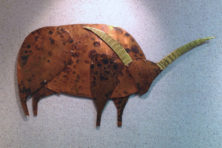In Memoriam: IsAbel
- Share
- Tweet
- Pin
- Share

When life is described as a journey, the writer is generally dealing in metaphors. But anyone talking about IsAbel is being quite literal. For Isabel Beaudoin’s life was a series of travels about the globe as she followed her love of art.
IsAbel’s earliest journeys took her as a child each summer to her grandparents’ farm in Michigan. Encouraged by her grandmother as a five-year-old she began drawing animals and the life she saw around her. While others were doing chores, IsAbel sketched.

Photo by Jeanne Kuhns.
Her next important journey took her to Milwaukee where she earned a degree in art education at UW-M. Her parents had wanted her to study history, but IsAbel told of seeing a photograph of a frieze on the Parthenon in an art history book and thinking, “Why can’t I make art rather than just studying it?” She did, changing her major from history to art, but as a concession to her parents, entered the school of education.
When IsAbel became an art teacher with the Green Bay Public School system, she also became a world traveler. Just as she had spent her girlhood summers on the farm, she spent the summers of her adulthood traveling not only in the U.S., but to countries in Central America, Asia, and Europe, studying at universities, touring and always sketching. Each fall she returned home to create art inspired by her travels and to incorporate the ideas she had gathered for her students’ art projects.
IsAbel also enjoyed summer travels from Green Bay to Door County. While the distance in miles was not far, the ground she covered in art was far greater, as she became the professional artist she had dreamed of being as a girl, first renting studio space at the Settlement Shops (She hung batiks she had made from tree limbs to dry!) and at the Red Barn complex; and in 1987 buying the building near Fish Creek that would become Gallery IsAbel. She served as an instructor at the Peninsula Art School, and in 2000 was honored as Master Artist by the Door County Art League.
Her artistic style was often characterized as primitive or naïve because of the sometimes childlike or ethnic or primal spirit that her work evoked.
Lucy Roske, who became her agent during the artist’s last years, said “IsAbel’s audience was never sure of her, she covered so many style and media. People respected her creativity, but never knew what to expect!”
And as for the characterization of IsAbel’s work, Roske said that the artist told people to call her style what they will, she didn’t care.
IsAbel created art her entire life. When aging and health concerns made her work more difficult, she found ways to cope. Roske became involved with IsAbel’s art when she needed help running her etching press. “I became her printer’s devil!” Roske said, and then she began helping with the gallery and eventually became her agent.
When her failing health took her to Scandia Village, special arrangements were made so that IsAbel could continue to paint. IZ (is), as her family and friends called her, was an artist throughout the journey of her life.
Isabel Beaudoin’s life will be celebrated at the Bemis International Center, St. Norbert College, from 1 – 4 pm on September 27.



